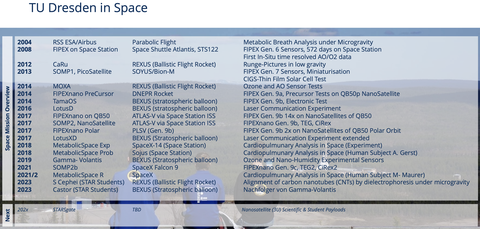Satellite Systems and Space Science
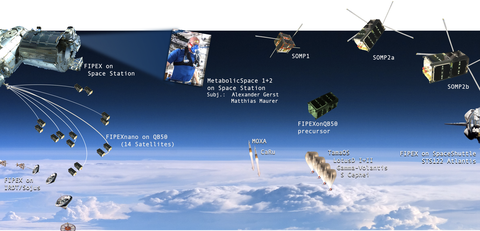
TU Dresden in Space
Scientists, PhD students and students develop pico- and nanosatellites, their subsystems and scientific experiments for satellites and space stations. In doing so, we work in the extremely exciting field of tension between new developments from physics, materials science and the challenging conditions in space. These provide new impulses and ideas that also return into earthbound applications.
In addition to the development and operation of scientific space experiments (see below), we are currently working in the following three areas:
- Development of a multifunctional foil for protection against electromagnetic interference and simultaneous transmission of adjustable frequencies for communication tasks.
- Development of a laser ice drill to study interplanetary ice on celestial bodies and to improve snow avalanche forecasting in the Alps.
- Development of a body-worn system for performance diagnostics of astronauts and space tourists.
News to SOMP2b on SpaceX Link
SOMP2 celebrates its first year of operation on 24.01.2022. Visit SOMP2b in orbit! It is recommended to book in time. Tickets for space tourists are booked out quickly!
News around MetabolicSpace conducted by astronauts Alexander Gerst and Matthias Maurer LINK
Contakt:
Dr.-Ing. Tino Schmiel Tel. 0351 – 463 38287 Curriculum vitae C.V.
Head of Research Field Satellite Systems and Space Science
Consultation opportunities for students at: https://bildungsportal.sachsen.de/opal/auth/RepositoryEntry/23325736972
Current Activities:
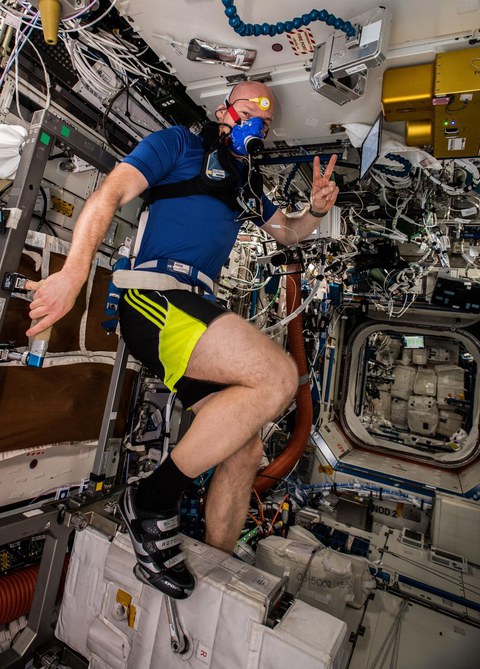
MetabolicSpace: Astronaut Alexander Gerst während der Experimentdurchführung
MetabolicSpace: Metabolic Diagnostic in Space by full wearable Respiratory Analysis
Astronauten: Alexander Gerst (2018), Matthias Maurer (2021/22)
- Cardio-pulmonary diagnosis in space during physical activities of Astronauts undisturbed due to wearable measurement system (mobile).
- Validation of the functionality of MetaSpace under a microgravity environment under astronaut handling.
- Gain experience for the enhancement of the MetaSpace system for personal / medical monitoring of space tourists
- Space Adaption, Qualification and Demonstration on Space Station ISS.
1st Mission launched 2018/2019 via Space-X to space station (cunducted by Astronaut Alexander Gerst)
2nd Mission launched 2021 via Space-X to space station (current in operation on ISS with Astronaut Matthias Maurer)
Related projects are supported by DLR, ESA, NASA

SOMP2 Flight Model during test campaign
SOMP2: Development of a Nano Satellite to operate scientific payloads in space
Nanosatellite SOMP2 - Student OnOrbit Measurement Project - is clompletely developed, built and tested, has a volume of only 20x10x10 cm3, at a mass of 2 kg, and is carrying 3 main payloads:
- FIPEXnano - small sensor system to investigate residual gas particles in space
- TEG - thermo electric generator to demonstrate energy harvesting in space
- CiREX - material experiment to investigate the influence of space environment on nano materials
SOMP2a launched in 2017 via ATLAS-V rocket to space station
SOMP2b launched 01/2021 via SpaceX Falcon-9 Transporter-1 (in operation)
Related projects are funded by DLR, BMBF, EU
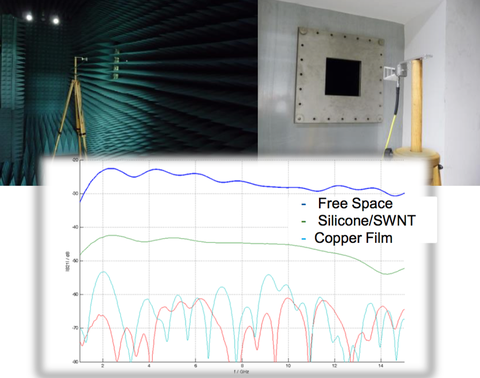
Electromagnetic radiation test of Carbon Nanotube Layers
CNT-EMI / CiREX: Investigation and Tests of Carbon Nano Materials in Space and Research on orientation behaviors of CNTs in electromagnetic fields.
The research focuses on the investigation of carbon nanotubes under harsh space condition (e.g. proton and electron radiation, visible light, atomic oxygen). We test these materials on ground and in space (CiREX on SOMP2 Nanosatellite). Applicaiton in space could be e.g. carbon nanotubes based electromagnetic interference (EMI) films. So we investigate the production and handling of carbon nanotube based composite and their alignment in electromagnetic fields in consideration of the environmental influence.
Current activities concetrate on the development of a multifunctional foil for protection against electromagnetic interference and simultaneous transmission of adjustable frequencies for communication tasks.
Related projects are funded by DLR
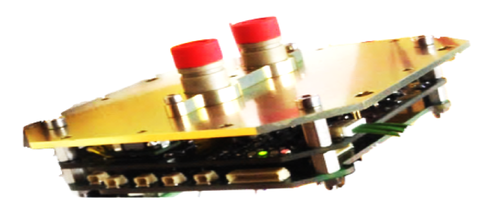
FIPEXnano Flight Model
FIPEXonQB50: Development and operation of a small measurement system to measure the residual atomic oxygen on multiple points in space
Very small electrochemical sensors have been developed, space qualified and integrated into a small housing including miniaturized eletronics and standard interfaces for easy integration on satellites; QB50 is an international network of small satellites for multi-point, in-situ exploration of the thermosphere. SOMP2 is part of it.
FIPEXnano is ready for flight on 14 Nanosatellites - launch is spread on two launch systems: ATLAS-V via space station and indian PLSV rocket.
Launched 2017 via ATLAS-V rocket and via Indian PSLV rocket
Related projects are funded by BMBF, EU, ESA, Industry
MOTAR: Development of a scalable and modular thermal analysis model for Pico and NanoSatellites, Investigation of new small componentes for thermal control
For Pico- and Nanosatellites we develop a user friendly tool that allows reseachers to analyse and control the thermal relations between various satellite components right from the beginning of the complex development process. We also develop and test new and small thermal control technologies applicable for these small satellites.
Related projects are funded by DLR

First test results of electrochromic layers
ELCH: Development of an electrochromatic space radiator with adoptable thermal emissivity and thermal absorbtivity
The temperature of a spacecraft is mainly influenced by the balance between absorption of solar flux and the emission of its own heat to the cold cosmic background. We develop adaptable surfaces to influence and control both: emissivity and absorptivity of the satellites surface, so heating and cooling of the spacecraft can be controlled at a time without folding radiators. This will lead to significant benefits in the electrical power subsystem and a lower overall mass of the spacecraft.
Related projects are funded by DLR and in house
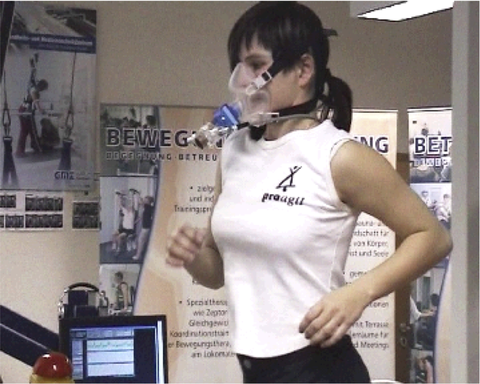
Space sensors applied for breathing analysis
Small Gas Sensors: Development of miniaturized electrochemical sensors and its overall system (sensor, housing, electronics, contacts) for extreme applications/ environments
- AO: Atomic Oxygen in space
- O2, CO2: Oxygen and Carbon Dioxide sensors for medical in-situ applications
- O3: Ozone measurement with small and mobile sensors
- NOx: Nitrogen Oxide Sensors for combustion
- H2/O2: Hydrogen Measurement of residual Hydrogen in Oxygen (and vice versa) and automotive applications
Related projects are funded by BMBF, AIF, BMWi, Industry
FlexTEG: Development, Characterisation and Demonstration of Thermoelectric Systems for Power Harvesting in Space
External and internal thermal loads on satellites induce high heat flows that are emitted to space. Thermoelectric generators (TEG) can convert these heat flows into electrical power - even during shadow phases. We analyse and test TEGs for autonomous supply of low-power-demands, although the efficiency of TEGs is expected to be low. Flexible TEGs can be attached to any curved surface, which makes them predestined for many space and terrestrial applications. With special consideration of the harsh space environment, we develop flexible thermoelectric layers which are printed on polymer substrates in thick film technology .
Related projects are funded by DLR, EU, SAB
TU Dresden in Space: Overview of Space Mission with high participation of students
Students from all disciplines are welcome to join us in this exciting field. Get in touch with us!

